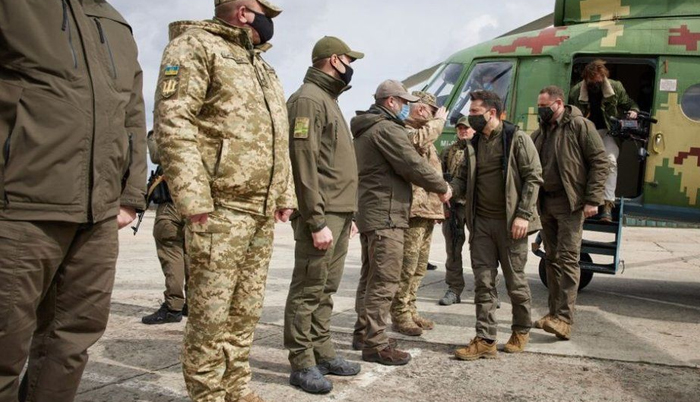
Ukraine’s President Zelensky has been visiting troops in the region
MOSCOW, April 10 (NNN-AGENCIES) — A top Russian official has warned that Moscow could intervene to help Russian-speaking residents in eastern Ukraine if Ukraine launches an all-out assault on separatists there.
Russian-backed separatist rebels and Ukrainian troops have been clashing in the east of the country.
Russia has also been building up troops on the border with Ukraine.
The deputy head of Russia’s presidential administration, Dmitry Kozak, said that Russian forces could intervene to “defend” Russian citizens.
“Everything depends on the scale of the conflagration,” he said, adding that an escalation could mark the “beginning of the end” for Ukraine – “not a shot in the leg, but in the face”.
He likened the current situation of the separatists to Srebrenica, the town in Bosnia-Herzegovina where 8,000 Muslim men were killed by Bosnian Serb forces in 1995.
“If, as our president says, there is a Srebrenica there, we shall probably have to come to their defence,” Kozak said.
President Putin first suggested in 2019 that Russian-speaking residents might suffer a Srebrenica-like massacre if Ukraine regained full control of Donbas without guarantees.
But there is no sign that Ukraine is preparing any such Bosnian Serb-style “ethnic cleansing” campaign.
Kozak suggested the rebels could hold their own for now against Ukrainian forces, as they consisted of “battle-hardened units”.
Ukrainian army commander, Gen Ruslan Khomchak, said “we see the build-up of Russian troops near Ukraine’s state border.
Russia has not detailed troop numbers, but the Ukrainian military asserted at the end of March that some 20,000 Russian troops had been moved towards Ukraine’s border. Video has emerged on social media of Russian trains moving heavy weaponry, apparently towards the region.
Ukraine says 25 of its troops have been killed in the conflict zone so far this year, and 50 died in the whole of last year.
Ukrainian President Volodymyr Zelensky visited the region on Thursday to see “the locations of the escalation” and “be with our soldiers in the tough times in Donbas”.
The roots of the conflict go back to March 2014, when Russia annexed the Ukrainian region of Crimea. Pro-Russian President Viktor Yanukovych had fled the Ukrainian capital Kyiv in February, after massive street demonstrations and clashes.
A month later, Russian-backed rebels in the mainly Russian-speaking Donbas seized much of the Donetsk and Luhansk regions.
Ukraine’s President Zelensky came to power promising to bring about peace, and a ceasefire was signed last July. Both sides have since accused each other of violating it.
The conflict is estimated to have killed 14,000 people. — NNN-AGENCIES




